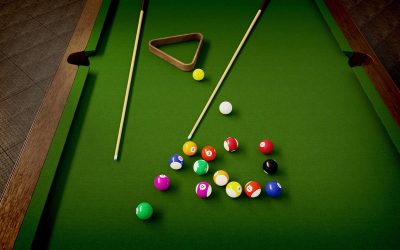
Properly setting up the pool balls is essential to guarantee an even and fun game. In addition to offering stability, a well-organized rack also creates the conditions for a seamless break, which has a big influence on the game’s flow. Comprehending the distinct racking requirements of various pool games might enhance your gameplay experience. This thorough tutorial will cover everything from the fundamentals of racking pool balls for different well-known games to the tools required, advice on creating the ideal rack, and typical blunders to watch out for.
Understanding the Basics of Racking Pool Balls
Importance of a Tight, Well-Structured Rack for a Fair and Consistent Break
A tight, well-structured rack is essential for a fair and consistent break. When the balls are tightly packed and touching, the force of the break is evenly distributed, leading to a more predictable spread of the balls across the table. This uniform dispersion is crucial for fairness, as it prevents any player from gaining an undue advantage from an uneven break. Furthermore, a tight rack helps prevent the balls from rolling off-course or clustering in a manner that can skew the game dynamics.
Making Sure the Balls Are Touching and Tightly Packed
A tight rack demands meticulous attention to detail. There should be no holes in the balls’ coherent, continuous formation. This can be accomplished by adjusting the rack and pressing the balls together with both hands.
Consistency
Maintaining consistency in your rack strategy is essential to preserving game fairness. This entails making sure that every time you rack the balls, the alignment and tightness are at the same level. You can attain this consistency by practising your racking technique on a regular basis.
YOU MIGHT ALSO LIKE:
Equipment Needed
Standard Triangle Rack
A standard triangle rack is a staple for many pool games, including eight-ball and straight pool. This rack holds 15 balls in a triangular formation. It’s essential to ensure the rack is sturdy and not warped, as an even rack is crucial for maintaining the tightness of the balls.
Diamond Rack for Nine-Ball
The diamond-shaped rack is designed explicitly for nine balls. It arranges the nine balls into a compact diamond shape, with one ball at the apex and the nine-ball in the centre. This specialised rack helps ensure the balls are positioned correctly and tightly packed for a consistent break.
Properly Cleaned and Uniform Pool Balls
Using properly cleaned and uniform pool balls is essential for a consistent rack. Dirt or residue on the balls can affect their roll and placement. Ensure that all balls are of the same size and weight to maintain the integrity of the game. Regular cleaning and inspection of the balls help achieve this uniformity.
Setting Up Racks for Various Pool Games
Racking for Eight-Ball Formation
- Formation: An ordinary triangle rack organises 15 balls in a triangle for eight balls.
- Positioning: The two balls in the back corner should be one solid and one striped, with the 8-ball in the middle of the triangle and the apex ball on the footpot.
- Tightness: Make sure every ball touches the surface and is firmly packed. To accomplish this without upsetting the configuration, press the rack forward and then lift it straight up.
Racking for Nine-Ball
- Formation: Nine-ball uses a diamond rack to arrange nine balls.
- Positioning: The 1-ball is placed at the apex on the foot spot, and the 9-ball is positioned in the centre. The remaining balls are placed randomly but should be tightly packed.
- Tightness: For a fair break, it is crucial to ensure all balls are touching and tightly packed. Use the diamond rack to align the balls correctly, then press them together before lifting the rack.
Racking for Ten-Ball
- Formation: Ten-ball also uses a standard triangle rack but with only ten balls.
- Positioning: The 1-ball is at the apex on the foot spot, the 10-ball in the centre, and the remaining balls are placed randomly.
- Tightness: Ensure the balls are tightly packed by pressing the rack forward and lifting it straight up. A tight rack helps in achieving a consistent break.
Racking for Straight Pool
- Formation: Straight pool, or 14.1 continuous, uses a triangle rack to arrange 15 balls.
- Positioning: There are no specific requirements for ball positioning in a straight pool, except that the apex ball is on the footpot. The goal is to have the balls tightly packed for a consistent break.
- Tightness: Ensure the balls are tightly packed by using both hands to press them together while adjusting the rack. This helps achieve a uniform spread of the balls during the break.
Advice for the Ideal Rack
1. Make Sure It’s Tight
A good break requires a tight rack. Press the balls firmly together with your hands or the rack itself. This seals off any spaces between the balls, preventing an uneven break. Maintaining tension during games like ten- and eight-ball can be achieved by pressing the balls forward with the triangle rack and then raising them straight up.
2. Verify Alignment
Verify that the rack’s base is parallel to the end rail and that the apex ball is precisely on the foot point. An unequal distribution of the balls during the break can result from misalignment. To guarantee that the 1-ball is positioned at the apex and the 9-ball is in the correct alignment for the 9-ball, use the diamond rack.
3. Use the Right Pressure
Apply even pressure when forming the rack to ensure all balls are in contact with one another. Uneven pressure can cause gaps between the balls, leading to an inconsistent break. Press the balls together firmly but not too hard, as excessive force can cause the balls to shift out of position.
4. Consistency
Aim to rack the balls the same way each time to maintain consistency and fairness. Consistent racking helps players develop a reliable break and ensures that no player has an unfair advantage. Regular practice and attention to detail help achieve this consistency.
Common Mistakes to Avoid
Leaving Gaps Between the Balls
Gaps between the balls can cause an uneven break, where the balls do not disperse correctly. This can lead to clusters of balls that are difficult to play and give an unfair advantage to the breaker. Always check that all balls are touching before lifting the rack.
Incorrect Ball Positioning for Specific Games
Each game has specific requirements for ball placement. For example, in eight-ball, the 8-ball must be in the centre, and nine-ball, the 1-ball must be at the apex with the 9-ball in the centre. Failing to follow these rules can lead to disputes and an unfair game. Familiarise yourself with the specific racking regulations for each game you play.
Not Ensuring the Apex Ball is on the Foot Spot
The apex ball must be correctly positioned on the footpot to ensure a fair break. If it is off-centre, it can cause the balls to disperse unevenly. Use a visual marker or align the apex ball with the head string to ensure it is correctly positioned.
Racking on an Uneven Table Surface
An uneven surface can lead to an inaccurate rack, where the balls are not properly aligned or tightly packed. Ensure the table is level before racking. If you notice any unevenness, try adjusting the table or repositioning the balls to achieve a tight rack.
Conclusion
A decent rack is necessary for an equitable and fun pool game. You may enhance your racking abilities and have better breaks and a more consistent gaming experience by using the right strategies and avoiding typical blunders. Having a tight, well-organized rack and knowing the precise racking criteria can make a big difference while playing eight-ball, nine-ball, ten-ball, or straight pool. You may improve your game and the overall enjoyment and fairness of the game for all players by honing your racking technique. Cheers to your successful racking!


